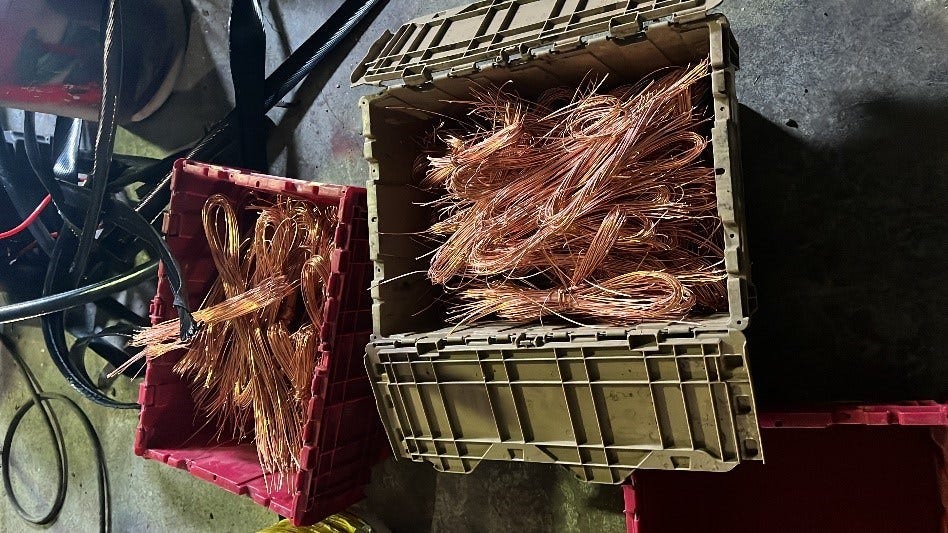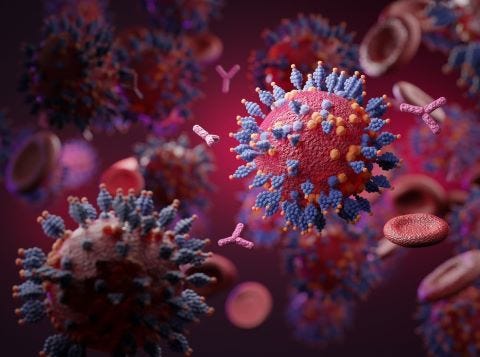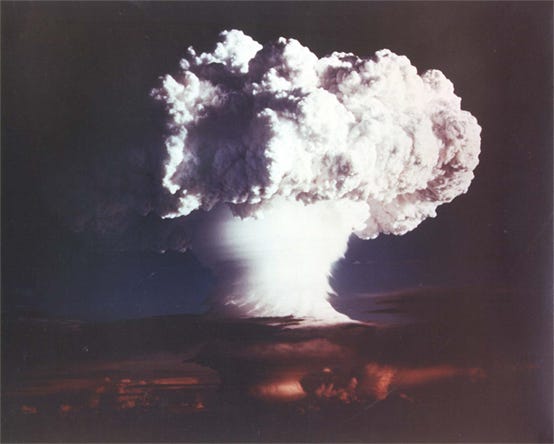Every edition features 7 stories, from the past week. I’ll draw on my background in media, journalism, agriculture, biotech, and renewable energy to come up with an interesting selection and do my best to offer some context.
Sometimes built around a theme, sometimes random, but with a Canadian twist.
On Monday, the United Nations released its World Wildlife Crime Report and it said that wildlife trafficking inflicts “untold harm upon nature”. Euronews describes the report as painting a “bleak picture”. As if climate change and environmental damage was not enough, of the 1,652 different species of plants and animals seized for illegal trafficking, 40% were already classified as threatened or near threatened.
The International Fund for Animal Welfare publishes a list of endangered animals in the Congo rainforest. All of the animals on the most recent list are being endangered by habitat loss, but everyone one of them were also subject to illegal trafficking of either the live animal, or parts of the animal.
There are well known examples of illegal trafficking such as elephant tusks, but much of it happens under the radar and is fueled by poachers living in poverty who help fill the high demand for medicine, pets, trophies, and rare ornamental species. The Guardian says that much of the wildlife crime is linked to organized crime and that corruption in some countries makes efforts to stop the trade difficult.
Solving the problem is not easy and while catching and punishing poachers seems to be the obvious answer, the root of illegal trafficking is the demand. Jail time usually targets the poor, while the distribution networks and the buyers are the rich. Biodiversity is at risk everywhere and the ripple effect of wildlife trafficking is making the situation worse. Wildlife belongs in nature, not in the marketplace.
The World Food Prize has gone to Dr. Geoffrey Hawtin OBE, Founding Director and Executive Board member at the Global Crop Diversity Trust, and Dr. Cary Fowler, currently the U.S. Special Envoy for Global Food Security. (Fowler earned his BA Honours degree from Simon Fraser University in British Columbia so we’ll take a wee bit of credit for his achievements) They received the prize for their work in creating the Svalbard Global Seed Vault.
The Svalbard facility was opened in 2008 and is often called the Doomsday Vault because it is there as a backup for humanity in the event of a global catastrophe resulting in the failure of crops. It is the biggest and most comprehensive seed vault, but it is not alone in the effort to preserve the plant resources of the past and present to ensure our future.
The oldest is the N. I. Vavilov All-Russian Institute of Plant Genetic Resources founded in 1894 by “Nikolai Vavilov: Father of Genebanks”. Located in St. Petersburg, it houses 345,000 plant varieties, many which have simply disappeared because of war or environmental changes.
The International Potato Center is a specialty facility that shares samples with scientists around the world to help in the development of new potato varieties that are adapted to changing climate conditions. It is also preserving potatoes, sweet potatoes, and their wild relatives, as well as a unique collection of Andean roots and tubers.
The Millennium Seed Bank was founded in 2000 by Kew Gardens in the United Kingdom. It is an underground climate-controlled refuge for 2.4 billion seeds from more than 39,000 plant, tree, and shrub species. Like the Svalbard Seed Vault, it is built to withstand climate extremes, floods, bombs, and radiation. The Guardian describes it as 1984-ish.
These and the many other seed vaults around the world are vital to maintaining biodiversity in nature and in agricultural crops. They will also help restart crops in the event of catastrophic events. Feel free to jump to the last story in this edition if you need a reminder of the latest catastrophe we may have in store for ourselves.
A running joke when I was at CBC was that if we were short of money, we could simply mine the ceiling for all the miles of copper wire running through it. The building has long since been torn down and who knows where all the copper went, but not much has changed when it comes to the demand for copper.
The world it seems, “has gone cuckoo for copper”.
Prices are up as much as 20% on the futures market according to the Wall Street Journal, demand is up, and amid already tight supply, it can take from 7 to 10 years before a new discovery makes it onto the market. As the world continues its energy transition, copper is integral to many clean energy technologies (An EV uses 3 times as much copper as a regular car for example) and the ever-expanding demand for electricity. Chile leads global mined copper production with 24% of the world’s supply and Canada comes in at 12th with 2.4%. However a new University of Michigan study says that copper can’t be mined fast enough to electrify the US.
Recycled copper is an important part of the copper market and as prices rise it is good for recyclers and for the supply chain. It is also good for thieves. Rogers Communications customers were hit with an internet, TV, and home phone outage last week during an attempt by thieves to steal copper wire, one thousand pounds of stolen copper wire were recovered in Southern Alberta, and in Riverview, New Brunswick, the local tennis club was hit by thieves who stole copper wire. The problem is becoming so severe that companies are developing special security measures to spot copper wire theft and Bell Canada is asking the federal government to change the way copper theft is charged under the criminal code.
The challenges are not going to go away soon, because in the long run there is simply not enough copper to go around right now. Changes in the structure of the industry to make it more efficient or mergers and acquisitions are not a solution according to an article in the Canadian Mining Journal. We simply need more of the stuff starting with the extraction and through to refining and manufacturing the final product.
That comes at an environmental and social cost. Listen to this podcast episode from WBUR radio in Boston and learn more about the copper trade-off.
I am not a fan of hunting. Never have been. And modern hunting is hardly a contest with high powered rifles, ATVs, and hunters safe in the knowledge that their GPS will guide them back to the comforts of home as darkness approaches.
Few today could take on the challenge of Stone Age hunters using primitive weapons with limited range. Those hunters had to be prepared to run after their prey. It also meant a fine balance between running themselves to the point of exhaustion when it finally came time to make the kill.
A new paper published in the peer reviewed Nature Human Behaviour concluded that those early hunters became skilled endurance runners. Skeptics had suggested the energy output was too great, while the paper says evolution played a role in the development of fatigue-resistant muscle fibers, the ability to sweat away the build-up of metabolic heat, and even the Achilles tendon. The paper’s authors (led by Eugène Morin from Trent University here in Canada) conclude that the “endurance pursuit (EP) hypothesis” is a valid argument in favour of endurance hunting.
The reality of our 2-legged physical abilities is that we are not the fastest or the strongest, so those early hunters had little choice but to become better at endurance. Our biomechanics helped make that a viable strategy. Today’s long-distance runners seem to have benefited from our distant ancestors who faced the challenge head-on and evolved to become good at it as a matter of survival.
Fortunately, we don’t have to run down a wild animal to provide meals for the week. Unfortunately, we can’t always rely on food we buy as being as healthy as it could be. Four Canadian academics from Université Laval, University of Calgary and University of Ottawa have been looking into what we eat and said in The Conversation this week that “big food companies can do more to create healthier food environments”. The researchers studied the nutrition related policies of major food and drink manufacturers in Canada and produced a report that you can download. The top performer was Unilever but overall, they found making healthier foods more available was not a priority for any of the companies.
What are your alternatives? This week on The National there was an interesting report that highlighted how Dollar Tree in the US provides some relief for consumers by offering fresh food as part of its discounted stock. Canada is not seeing the same trend though the story did point to some efforts being made up here. You may not view chains such as Dollarama or Dollar Stores as grocery stores, but they do offer canned goods and packaged foods that can make a difference on your food bill. And once consumers find that it does make a difference, they may change their buying habits which will put pressure on the major grocery chains.
The researchers outlined 6 areas where they could improve to help provide healthier food choice. My inner cynic says that would not please corporate shareholders who are not the ones struggling to make ends meet.
A virus is a tiny organism that needs a host to reproduce, and it has no shortage of hosts in our world. Viruses are found in virtually every form of life from animals to plants and even inside bacteria and single cell archaea. According to the Harvard Museums of Science & Culture they have been around for 4 billion years.
They have always mutated and always will, and as a result we have new viruses on the horizon that could cause new epidemics according to researchers led by the German Cancer Research Center. Like the movie Groundhog Day, we will see SARS-COV-2 like epidemics again and again. Even as recently as a few days ago we had news of yet another COVID-19 variant according to the UK Health Security Agency.
Apart from the ability of viruses to mutate and become more infectious, climate change is creating ideal conditions (free Washington Post link) for viruses to thrive and for hosts such as mosquitoes and ticks to help them spread.
Right now, we are witnessing the spread of the H5N1 strain of avian influenza and for the moment, it is not a serious threat to people. But we need to consider that whole mutation thing that viruses do with such abandon. It is well within the range of natural possibilities for the virus to mutate and mix with the human influenza virus and make a new combined pathogen. Using wastewater testing which was so effective at tracking COVID, the US Centers for Disease Control and Prevention is launching a wastewater dashboard to keep an eye on the bird flu spread. In Canada researchers and infectious disease specialists have observed the diversity of mammals affected by H5N1 and say the risk of spread to people is “profound” according to a CTV News story.
Meanwhile, norovirus cases are on the rise in Canada and measles continues its Canadian comeback. And remember Monkeypox? Now known simply as Mopox, it too is back in the news.
No one is suggesting we are on the verge of another pandemic, but it never hurts to realise that viruses have been around longer than humans and have shown their ability to change, adapt, and yes, kill. As the New York Times points out, hopefully we learned something the last time around.
https://weather.com/science/environment/video/climate-change-raising-the-risk-of-another-pandemic
So you are healthy, your vaccinations are up-to-date, and you practice reasonable hygiene so are less likely to catch the latest virus. Phew.
Hold on, you are not out of the woods yet.
How about a nuclear war?
You could be reassured by the principle of nuclear deterrence which is based around atomic weapons being so destructive that nations would never deploy them. Then again, there are nine countries with nuclear weapons and they keep an estimated stockpile of 13,000 of them handy.
While unthinkable in practice, we are seeing a new round of nuclear rhetoric such as that inferred by Senator Lindsey Graham on Mothers’ Day (Timing is everything Senator). Iran is also moving in the wrong direction as the county’s internal debate about developing a nuclear weapon is shifting. A shift the director general of the International Atomic Energy Authority said is “extremely serious” in an interview with The Guardian. Earlier this month Russian President Putin rattled the war sabres by ordering the military to run drills involving the deployment of tactical nuclear weapons. Such weapons are smaller and designed to be used on the battlefield, but they are still extremely destructive and would change the face of the war in Ukraine and probably everywhere else as well. They are not covered by any arms control agreements. Al Jazeera has a slightly more optimistic view of what appears to be a game of brinkmanship and suggests that it could instead pave the way for a diplomatic solutions.
When I was a university student I did my share of protesting war – particularly the threat of a nuclear confrontation.
Today we are seeing more of what Stephen Stills wrote about in his song For What It’s Worth where he took a poke at protesters “Singing songs and carrying signs Mostly say, "Hooray for our side".
War is seldom a good thing and maybe it is time to go back to protesting the global threat it poses. The Doomsday Clock remains at 90 seconds to midnight and I for one, wish it was not so close to the top of the clock.
Read, comment, subscribe, and share this newsletter.
I’m available for contract and freelance work with not-for-profits and charities. With 40 years of experience behind me and lots of time ahead of me, I’m here to help you make a difference in your media relations, public relations, and general communications needs.





